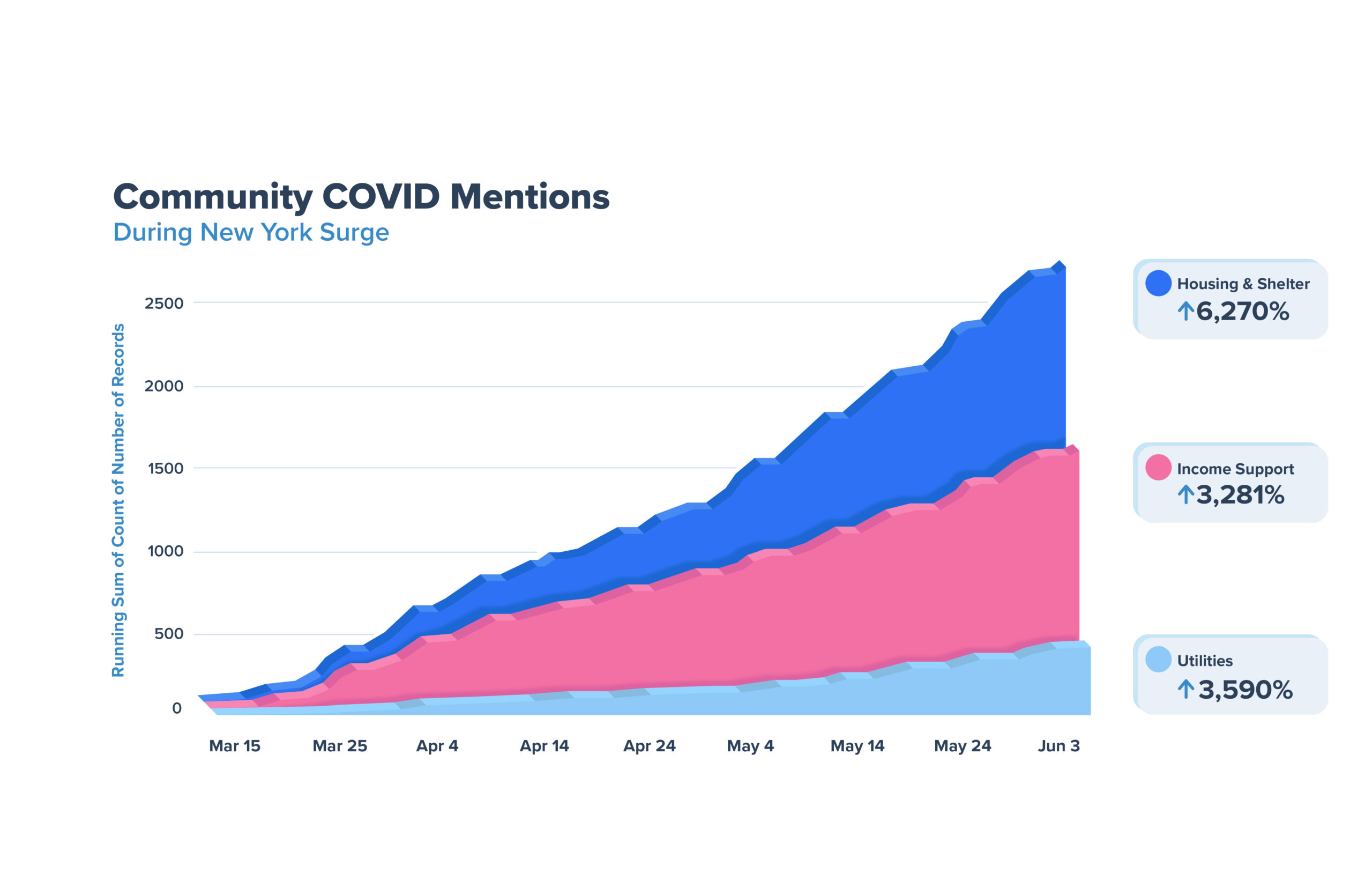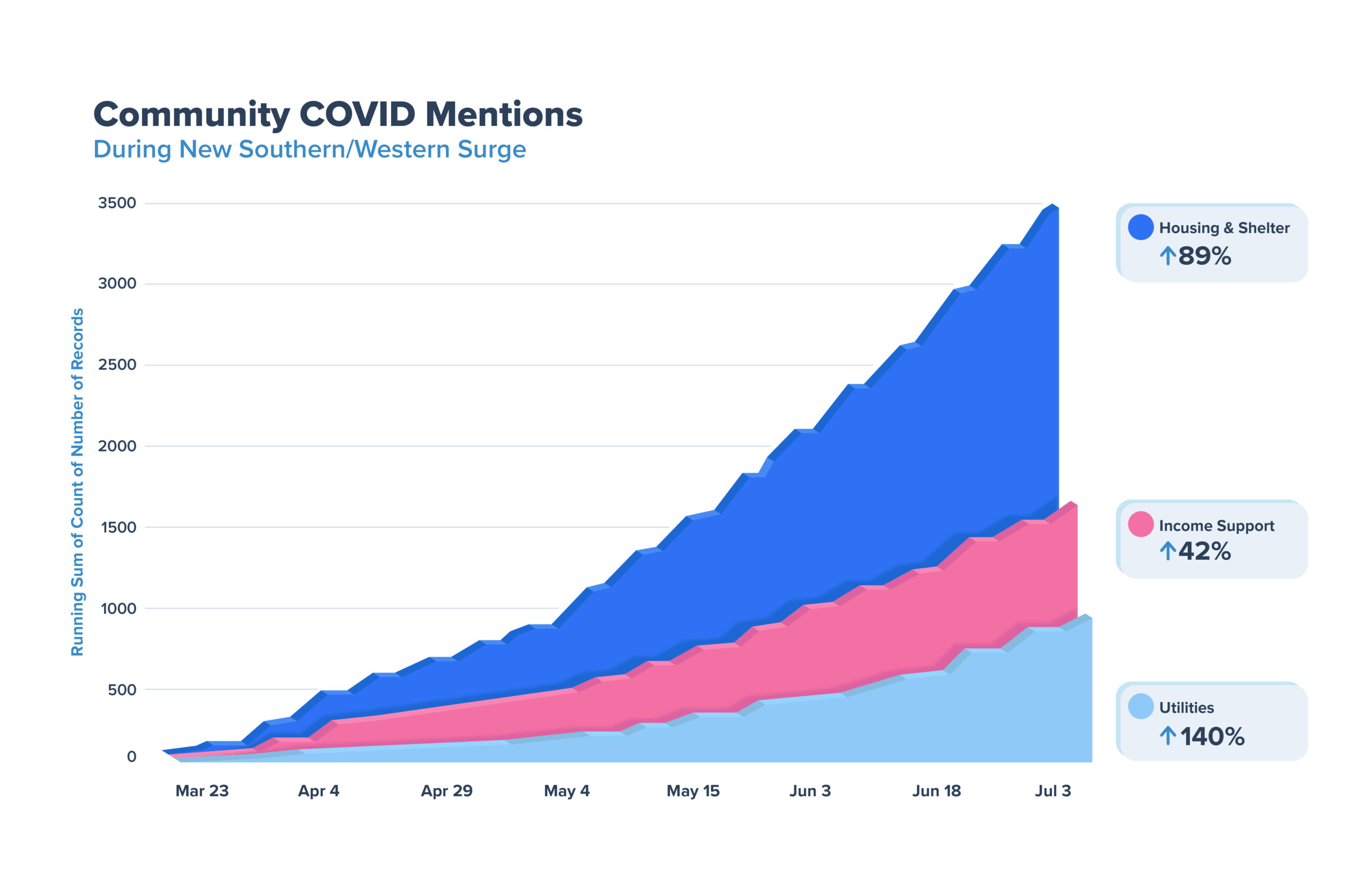
Data Lessons from New York’s COVID-19 Surge
Most of us spent March through June gripped by the news coming out of New York State, while government and citizens faced the worst COVID-19 outbreak yet in our country. The New York curve occurred from March 1st when the first COVID-19 case was detected, to June 8th when New York City began a Phase One re-opening. We learned many lessons during this time that should now serve the rest of the country as the pandemic enters a devastating new stage.
A Social Care Crisis
New York experienced its surge with the benefit of quickly enacted eviction moratoria and the passage of the first two Congressional stimulus packages. Even with these vital protections, New York State’s unemployment system collapsed under a record number of claims, and social care needs skyrocketed.
Today, as the virus spreads like wildfire across the South and large swaths of the West, many communities will face a surge in infection rates, hospitalizations, and the resulting social needs crisis without:
- Eviction bans (many set to lapse this month)
- The $600 weekly Federal unemployment benefit (ending July 31st)
- Clear plans for schools or childcare
Regardless of employment, people need to feed their families and provide for basic services. Many will not be able to pay their rent. The result? One leading expert estimates that homelessness is likely to increase 40-45% as compared to 2019. It is common knowledge that community-based organizations will bear the brunt of this fallout, but is there another critical role they can play in stopping the spread?
Community Entry Points of Care – A Key Testing and Contact Tracing Opportunity
On Saturday, America broke its own record and hit 74,000 new COVID cases in a day as hospitals in the South and West near full capacity. To reduce the stress on the public health system, it’s critical to identify other points of entry to help identify individuals for testing and contact tracing before they hit the healthcare system. In the absence of a national strategy, counties and states have been left to devise their own testing and contact tracing protocols.
As we took a deeper look at our national Unite Us network, comparing data from the New York surge to the latest surge, we asked the question: Where are we seeing the most COVID mentions from individuals seeking help, and could this be a key for state agencies as they develop or improve their testing strategies?
In fact, New York’s surge showed a steady and steep increase in COVID mentions at three specific points of entry across our social care networks: housing and shelter, utilities, and income support. This information offers potential lessons for our networks in 38 states across the country. State agencies, counties, and healthcare partners should be able to pinpoint spikes in COVID mentions within their communities weeks before individuals potentially wind up in a healthcare setting.

Community COVID Mentions During New Southern/Western Surge
Looking at our network data from June 1st – June 8th as this new surge across the South and West occurs, we are already starting to see similar drastic spikes in COVID mentions in those three same service types, representing the largest groupings of mentions across all service types: housing and shelter, utilities, and income support.

Increased Social Care Demand and Changing Profiles: More Opportunity for Testing
Our data and analytics team continues to monitor changes in needs across the country and has identified a growing demand for Utilities and Housing, which we expect to rise. In a one-week period from June 14th to June 21st, Unite Us networks nation-wide experienced a 200% surge in requests for utility assistance, indicating a clear need for financial support. Since mid-March, Unite Us has seen a 220% increase in services provided for housing.
The faces of those seeking help are shifting as well. Our United Way of South Hampton Roads partner in Norfolk, VA shared the story of one single father:
A gentleman called asking for help paying his rent. He had been laid off from his job as a result of the coronavirus outbreak. He is the single father of a one-year-old son. As I went through the questions, working to identify what other needs he may have, he shared that he was very worried about losing his son and that he didn’t normally ask for help, but he knew that if he lost his home, he could very likely lose custody of his son. I asked if he had food and he said he had some noodles and bread that would get them through for a little while. I let him know of school breakfast sites near their home and lunch pick up locations from the food bank to make sure they could get by while we coordinate additional resources.
Thanks to our network partners, more and more individuals who have never sought help before are being connected to care. Our partners, in turn, are able to use their network data to learn where they have gaps in service as social needs rise, how quickly they can deliver services, and who in their community is being most impacted by COVID-19.
While this increased demand for social care is devastating and only likely to grow, it offers a unique opportunity to meet people where they are, at a time when strategic community-based testing and contract tracing is critical to our country’s ability to stop the spread of COVID-19.
Join us to build a solution fortoday, tomorrow, and the future:
About Unite Us
Unite Us is the nation’s leading software company bringing sectors together to improve the health and well-being of communities. We drive the collaboration to predict, deliver, and pay for services that impact whole-person health. Through Unite Us’ national network and software, community-based organizations, government agencies, and healthcare organizations are all connected to better collaborate to meet the needs of the individuals in their communities.



